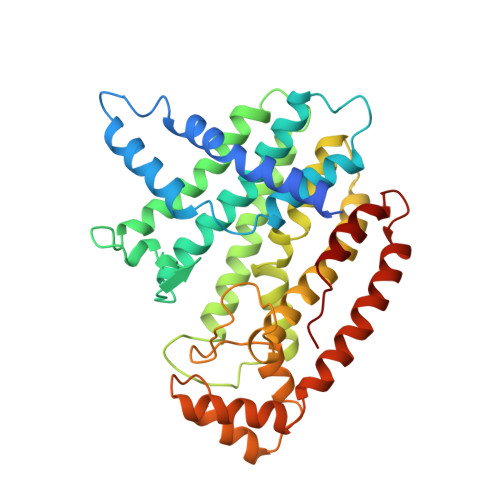Regulation of product chain length by isoprenyl diphosphate synthases.
Tarshis, L.C., Proteau, P.J., Kellogg, B.A., Sacchettini, J.C., Poulter, C.D.(1996) Proc Natl Acad Sci U S A 93: 15018-15023
- PubMed: 8986756
- DOI: https://doi.org/10.1073/pnas.93.26.15018
- Primary Citation of Related Structures:
1UBV, 1UBW, 1UBX, 1UBY - PubMed Abstract:
An analysis of the x-ray structure of homodimeric avian farnesyl diphosphate synthase (geranyltransferase, EC 2.5.1.10) coupled with information about conserved amino acids obtained from a sequence alignment of 35 isoprenyl diphosphate synthases that synthesize farnesyl (C15), geranylgeranyl (C20), and higher chain length isoprenoid diphosphates suggested that the side chains of residues corresponding to F112 and F113 in the avian enzyme were important for determining the ultimate length of the hydrocarbon chains. This hypothesis was supported by site-directed mutagenesis to transform wild-type avian farnesyl diphosphate synthase (FPS) into synthases capable of producing geranylgeranyl diphosphate (F112A), geranylfarnesyl (C25) diphosphate (F113S), and longer chain prenyl diphosphates (F112A/F113S). An x-ray analysis of the structure of the F112A/F113S mutant in the apo state and with allylic substrates bound produced the strongest evidence that these mutations caused the observed change in product specificity by directly altering the size of the binding pocket for the growing isoprenoid chain in the active site of the enzyme. The proposed binding pocket in the apo mutant structure was increased in depth by 5.8 A as compared with that for the wild-type enzyme. Allylic diphosphates were observed in the holo structures, bound through magnesium ions to the aspartates of the first of two conserved aspartate-rich sequences (D117-D121), with the hydrocarbon tails of all the ligands growing down the hydrophobic pocket toward the mutation site. A model was constructed to show how the growth of a long chain prenyl product may proceed by creation of a hydrophobic passageway from the FPS active site to the outside surface of the enzyme.
- Department of Biochemistry, Albert Einstein College of Medicine, Bronx, NY 10461, USA.
Organizational Affiliation:
















